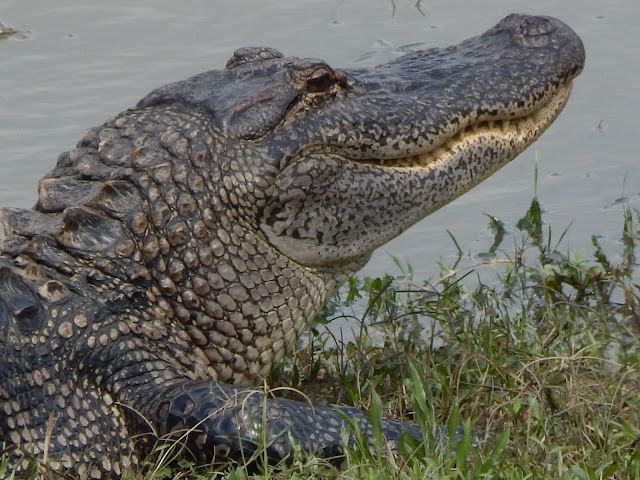 |
| Prothonotary Warbler (...looking for Easter eggs?) |
One highlight was the Osprey that flew over at the north end of Duck Lake. (Recently, on April 8, I saw one by the highway 8 bridge over Little River, roughly 15 miles to the west of this sighting, as the crow-- er, Osprey flies.)
 |
| female Prothonotary Warbler gathering nest materials, Catahoula NWR Willow Lake Unit |
 |
| Prothonotary Warbler, Headquarters Unit |
 |
| Prothonotary Warbler, Willow Lake Unit |
At the Willow Lake Unit, the second growth hardwoods continue to progress, becoming habitat for woodland species. There were Swainson's Warblers and Hooded Warblers singing at about the same spots where they were regularly heard the previous breeding season. I didn't hear Kentucky Warbler, though by the time I got to WL Unit, it was past prime birding time and they may simply not have been singing.
video: song of Swainson's Warbler and Hooded Warbler (and Northern Cardinal)
Combined list for these two locations is below -- the first number after the species name is for number of individuals encountered at Headquarters Unit, the second number is for Willow Lake.
After that, a few things about the non-avian wildlife.
 |
| Great Blue Heron, HQ Unit |
La Salle Parish, Louisiana
Headquarters Unit - 7:49 am to 11:48 am; 2.2 miles, birded from vehicle w/ numerous stops; conditions: 68 to 72 degrees F., cloudy becoming mostly sunny by end, light breeze, water level marker at north end of Duck Lake showed about 38.3 feet.
Willow Lake Unit - 11:52 am to 12:41 pm; 1 mile, birded from vehicle w/ numerous stops; conditions: 73 to 77 degrees F., mostly sunny, light breeze.
Habitat shots:
 |
| Headquarters Unit |
 |
| Headquarters Unit |
 |
| north end of Duck Lake, HQ Unit |
 |
| Sedge Wren habitat, Willow Lake Unit |
 |
| Willow Lake Unit -- Prothonotary Warbler spot |
 |
| Willow Lake Unit |
 |
| female and male Wood Ducks, beside entrance to HQ Unit (Thanks to the fellow who stopped and told me to look for the ducks here on my way out.) |
Double-crested Cormorant - 1, 0
Anhinga - 1, 0
 |
| Great Blue Heron, HQ Unit |
 |
| Great Blue Heron, HQ Unit |
Great Egret - 2, 1
Snowy Egret - 2, 0
Little Blue Heron - 2 (adult), 0
Black Vulture - 4, 5
Turkey Vulture - 4, 2
Osprey - 1, 0
Red-tailed Hawk - 1, 0
Killdeer - 1, 0
Mourning Dove - 2, 0
Barred Owl - 1, 0
 |
| Snowy Egret, HQ Unit |
Red-bellied Woodpecker - 4, 0
Downy Woodpecker - 1, 0
Pileated Woodpecker - 2, 1
Great Crested Flycatcher - 3, 0
White-eyed Vireo - 10, 7
Yellow-throated Vireo - 1, 0
Red-eyed Vireo - 6, 0
Blue Jay - 2, 0
American Crow - 5, 3
Purple Martin - 1, 1
Barn Swallow - 1, 0
Carolina Chickadee - 10, 2
Tufted Titmouse - 3, 2
Sedge Wren - 0, 3 (singing from dense eastern half of weedy meadow)
Carolina Wren - 12, 2
Blue-gray Gnatchatcher - 2, 2
 |
| Prothonotary Warbler, Willow Lake Unit |
Black-and-white Warbler - 1 (singing), 0
Prothonotary Warbler - 8 (many singing, many seen), 2 (an apparent pair)
Swainson's Warbler - 0, 2 (singing)
Common Yellowthroat - 3 (singing), 2 (singing)
Hooded Warbler - 1 (singing), 4 (singing)
Northern Parula - 2 (singing), 2 (singing)
Prairie Warbler - 0, 1 (FOS, singing)
Yellow-breasted Chat - 3 (singing), 1
White-throated Sparrow - 6, 0
Eastern Towhee - 2, 2
Summer Tanager - 4, 0
 |
| Summer Tanager, HQ Unit |
Northern Cardinal - 14, 3
Blue Grosbeak - 0, 1 (male seen singing)
 |
| male Blue Grosbeak, WL Unit |
 |
| male Indigo Bunting, HQ Unit |
 |
| male Painted Bunting, HQ Unit |
Common Grackle - 10, 0
Brown-headed Cowbird - 13, 1
Orchard Oriole - 1, 2
(video: Common Grackle and Red-winged Blackbirds)
Other Wildlife:
 |
| Western Mosquitofish, Willow Lake Unit |
Blanchard's Cricket Frog can be heard in video below:
 |
| American Alligator |
Both Virginia Opossum and Northern Raccoon were seen crossing the road. Eastern Fox Squirrels were out in force when I first arrived, with eight or so out on the grass between the entrance gate and the buildings. One of them really stood out. I don't recall ever seeing an 'all-orange' individual before. It was really quite something to see. This "ginger" color morph is something I'm not familiar with; I'll have to look into it.
 |
| unusual color morph Eastern Fox Squirrel, HQ Unit |
Butterflies included: Checkered-Skipper species, Black Swallowtail,
 |
| Black Swallowtail, Willow Lake Unit |
 |
| Pipevine Swallowtail, HQ Unit |
 |
| Eastern Tailed-Blue, HQ Unit |
 |
| Eastern Tailed-Blue, HQ Unit |
 |
| Pearl Crescent, HQ Unit |
A few wildflowes...
 |
| Spider Lily (Hymenocallis) |
 |
| Winter Vetch (Vicia villosa) |
Among those in bloom were: Spider Lily (Hymenocallis), Venus's Looking-Glass (Triodanis), Buttercups (Ranunculus), Annual Blue-eyed Grass (Sisyrinchium), Winter Vetch (Vicia villosa), Common Vetch (Vicia sativa), Groundsel (Packera), Crimson Clover (Trifolium incarnatum), Red Clover (Trifolium pratense), and White Clover (Trifolium repens), Pink Ladies (Oenothera speciosa), Swamp Milkweed (Asclepias), White Morning-Glory (Ipomoea lacunosa), Smartweed (Persicaria), Carolina Nightshade (Solanum), Brazilian Verbena (Verbena brasiliensis), Sida.
Hopefully I got all those correct -- plants are not my forte.























